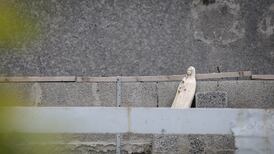Ireland’s first underground seismic station has been installed, allowing earthquakes from around the world as well as those much closer to home to be detected and analysed.
Dr Martin Möllhoff, director of seismic networks at Dublin Institute of Advanced Studies (Dias), explained that the new seismic station, located some 60 metres down in the Mitchelstown Cave between Mitchelstown and Cahir, is the first of Ireland’s nine seismic stations to be located underground.
“Mitchelstown Cave was chosen as a site for installing a permanent seismic station due to its location within the quiet Galtee-Vee valley, where the station is protected from seismic noise sources such as wind, rain and heavy road traffic,” he said.
Dr Möllhoff explained that the gseophysics section of Dublin Institute of Advanced Studies operates the Irish National Seismic Network, under a joint agreement with Geological Survey Ireland, a division of the Department of the Environment.
READ MORE
Thanks to the new underground seismic station at the Mitchelstown Cave, earthquakes from around the world will be detected and since its installation in May, he explained the station has already detected earthquakes as far away as southern Peru and the Fiji Islands.
“The addition of the new seismic station at Mitchelstown Cave will contribute greatly to our understanding of what lies beneath Ireland and the structure of the Earth as a whole,” said Dr Möllhoff, adding that it is hoped to increase the total number of seismic stations in Ireland to 12.
“Most people think there are no earthquakes in Ireland but there are smaller earthquakes happening all the time. It is important that we are aware that, even though we may not feel it, the world is moving slowly beneath us all the time.
“Since the beginning of 2022 we have actually detected eleven earthquakes in and around our shores — all of this information is fed back to our data centre at Dias allowing us to understand the world beneath us.”
Not always detectable
Prof Chris Bean, Head of Geophysics at Dias said that being able to install a seismic station so deep underground within a quiet rural landscape such as the Galtee-Vee valley meant that it could provide information not always detectable in other stations.
“Having a seismic station located deep underground within the quiet Ggeophysicsaltee-Vee valley provides us with a unique opportunity to collect high-quality data that is not adversely affected by human activity such as building sites and road and rail traffic,” he said.
This allows the Irish National Seismic Network (INSN) to detect Ireland’s small earthquakes and to allow INSN to feed real-time data on local and global earthquakes to the international scientific and public safety communities 24/7, he said.
“We are currently nearing completion of a total physical upgrade of the Irish National Seismic Network through a collaboration agreement with Geological Survey Ireland, which commenced in 2018,” he added.
Koen Verbruggen, director of Geological Survey Ireland, also welcomed the addition to the INSN and congratulated the Dublin Institute of Advanced Studies on the continued expansion of the network.
“The inclusion of Mitchelstown Cave will add a new dimension to the data and will be of great benefit to the science, our understanding of Ireland’s subsurface, and as a tool for science education,” he said.
For more information on seismic activity in Ireland, visit https://www.insn.ie. A map of the station network is displayed at: https://www.insn.ie/about.













